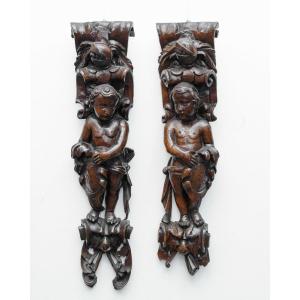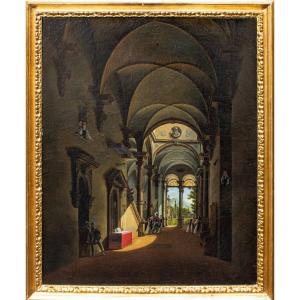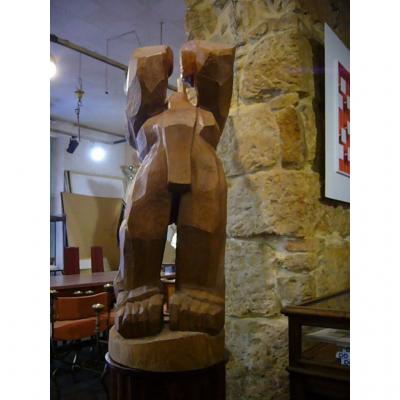Columns of grapes and vines
(2) Wood, cm h. 125
These precious columns of gilded wood, referring to the seventeenth century, demonstrate the skill achieved by the Italian craftsmen of the time given the difficulty of processing the tortile type. The sophisticated spiral lightens the structure, giving momentum and vitality to an architectural element that seems in perpetual motion. The spiral definition also recalls the plant world, here accentuated by the refined decoration of vine shoots and grape clusters that follow each other along the stem. Leaves and berries are not merely decorative and architectural element, but a real sculptural work, to be admired for the attention to detail and care in the volumetric rendering. The columns also have a strong polychromy, where the golden opulence of the capital and the vine branch contrasts with the brownish tone of the column and the greener tones of the leaves and grapes.
The column of tortile is also called "Solomon’s column" because, according to Christian tradition, it was the element suggested by God to Solomon at the time of the construction of the Temple of Jerusalem (10th century) and therefore considered divine architecture. Used already in the early imperial age, especially in sarcophagi, the column turtleneck soon became an interesting architectural variation of the classic longilineo stem, spreading also in the paleochristian environment. It was from 70 A.D. that the tortile column began to acquire a religious significance: after the destruction of the temple of Jerusalem, in fact, the emperor Constantine donated the tortile columns of Parian marble that, originally six and then increased to twelve by Pope Gregory III in the seventeenth century, they went to form the ancient Pergula of San Pietro in the homonymous Basilica.Very used in the Romanesque age, the spires were partially set aside in the Renaissance era, when they returned to look at the classicism of the smooth or fluted column, making their reappearance in Rome at the beginning of the 16th century, first in the paintings of Raphael and his school, and later in mannerist architecture. The pinnacle of splendour was reached in the Baroque period, as witnessed by the famous example that made school, or the Baldacchino realized by Gian Lorenzo Bernini in 1624 in the Basilica di San Pietro, with its imposing bronze twisted columns.
From a more symbolic point of view, the columns were often used by the Christian tradition as a metaphor for the one who won the battles of the spirit (Revelation 3:12). In the present couple the allegorical meaning is further enriched with the significant presence of vine shoots and grapes that, in the Bible, assumed functions of well-being, fertility and blessing; to it is also connected wine, symbol of joy, wedding party, of alliance. Jesus himself defines himself as life (Gospel according to John 15,1-8): he is the source of true life, while believers are the branches; living united to him, like the branch of the vine’s sap, enjoy full life and bear fruit.
Another possible reading is the secular one, which sees the vine as a symbol of wine, of the world of Dionysus and Bacchus, to be connected to the concepts of abundance and wealth.










































 Le Magazine de PROANTIC
Le Magazine de PROANTIC TRÉSORS Magazine
TRÉSORS Magazine Rivista Artiquariato
Rivista Artiquariato